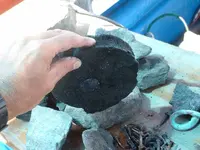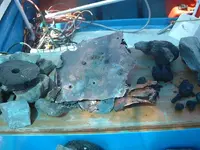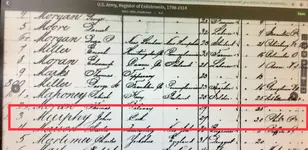Okay,
THE ONLY THING I ASK OF ANYBODY BEFORE POSTING, IS THAT THEY READ THE ENTIRE POST FIRST
(I know it is long, but it contains a lot of referenced information)
Here we go with one of the all-time most contentious subjects in all of the Treasure Hunting World:
Hidden/Lost Jesuit Treasures
Funny thing, as I write this, the movie National Treasure just came on! HAHAHA
Where to start, where to start, where to start? I guess I should start with what might constitute a Jesuit Treasure;
1. Gold and Silver Bars, Coins and the like.
2. Candlesticks, Monstrances, Ciboria, and various other Church Vestments made of precious metals in quantities large or small.
3. A combination of numbers 1 and 2.
4. The exploration of the areas, conversions of the heathens, and aid they rendered to those converted.
First, nobody can argue that number 4 is not absolutely true. Both the spiritual and exploratory work they did from 1608 until their expulsion in 1767 was a wonder for the ages. An example of how a small group of determined people can make such extraordinary advances in the knowledge base of mankind and bringing the light of God into the hearts of so many people in a frightening new world. One has only to read about Padre Kino SJ and his changing of world maps that previous to his explorations showed California as an island. He was the first to contradict that idea. Other testaments lie in all the missions that were manned by the tiniest number of Jesuit Fathers in some of the most hostile territory on Earth. Many of them gave their lives in the most gruesome manners imaginable at the hands of those that fought the changes they wanted to bring.
Next, I would like to talk about number 2. Of all the Jesuit Treasures, this possibility is the most believeable to most people who are of a more skeptical bent. While some diehards do not believe that even these are possible, I give you the words of one of the most DIE HARD of all Jesuit Treasure Skeptics: Father Charles W. Polzer SJ; in the Aug 1962 edition of Desert Magazine, as part of a larger article on preserving the old missions and other historically significant places he writes:
While he does go on to say that no Church records have been found that verify this possibility, he DOES say that it is a possibility. For those of you who know Father Polzer's stance on the subject, it was indeed a revelation to me when I first read it.
We need to know why the Jesuits would want to amass such wonderous vestments in the first place. In some miserable mud hovel in an arid remote hostile desert setting, what would be the great need to have such things? Well, Father Johann (Juan) Nentvig SJ, in his book "Rudo Ensayo" spells it out so that even a person not having any secret Church knowledge can understand:
There you have it! A Jesuit Father himself quoting the very words of the Founder of the Jesuit Order: SAINT Ignatious Loyola! So, now we know WHY the Jesuits would want to accrue such beautiful and costly appointments, but do we have any evidence, other than what Father Polzer SJ calls a "possibility"? You bet your sweet bippy we do! We have the words of some of the Jesuit Fathers themselves. Why don't we start with our old friend, Father Johann Nentvig SJ (again from Rudo Ensayo):
That's pretty good. Anything else? You betcha! Why don't we read the words of Father Joseph Och SJ, in a passage from his journals (Missionary in Sonora; the travel reports of Joseph Och, S.J., 1755-1767):
WOW! THAT'S AMAZING! Right from the horse's mouth. Let me here add a couple of points of fact so that the reader can make a more informed decision:
1. Father Nentvig's Journals are beyond reproach. There is no doubt he wrote the words that I have attributed to him.
2. Father Och's Journals are not 100% attributable. We know that he put them all together during his final years while he lived at the Jesuit College at Wurzburg, Bavaria. He passed away in 1773. Thirty-six years after his death in 1809, a book called "Der S.J. in Neumexico. Nachrichten von seinem Reisen nach dem Spanischen Amerika, seinem dortigen Auftenthalte vom Jahr 1755 bis 1767, und Rückkehr nach Europa 1768. Aus dessen eigenhändigen Aufsätzen" was published. These were the collected writings of Father Och SJ. His journals were kept at the Jesuit College in Wurzburg until most of the city was destroyed in an Allied Air Raid in 1945. I have not personally been able to locate them after that. So, while it is remotely possible that some parts of his journals MAY not have been written by Father Och, all one has to do is to read the entire book translated by Theodore E. Treutline to understand that it is HIGHLY unlikely that those were not the actual writings of Father Och SJ. I ONLY included this in the interest of being intellectually honest in what I say (unlike some). A final note about this journal's authenticity: While Lamar may have his doubts (whoever Lamar may be), the two most eminent Jesuit Historians of North America (Father Ernest J Burrus SJ and Father Charles W Polzer SJ have both worked on Theodore Treutline's Translation of "Der Glaubenspredigers ~" and neither of them seem to have any doubt whatsoever that those are the true and correct journals of Father Och SJ, and Theodore Treutline himself one of the most prolific translators of German Jesuit Writings did not doubt their veracity. I guess Lamar holds himself in very high regard. HAHAHA
Now. let us move on to numbers 1 and 3. There are no historical documents stating that the Jesuits possessed ANY stores of gold and/or silver bars, coins, etc. What we have, are a couple of documents that are SUPPOSED to be inventories of treasures that were hidden before the Jesuits were expelled from the New World during the night of 25-26 June 1767. Those who are familiar with histories written by Father Ernest J Burrus SJ, Father Charles W. Polzer SJ, Traditional Historians, and most history books detailing Colonial Spanish times in the New World are right now saying "THAT IS IMPOSSIBLE! King Charles III made certain that his orders to arrest all the Jesuits, march them to the sea, and ship them all back to Europe, were sealed and COMPLETELY secret until the day they were to be arrested! WRONG! Well, not completely wrong. They were supposedly a secret to everybody that received the King's Letters. There are a few little niggling facts that keep getting omitted from most of that history you have read. Surprised? I was!
First, here is a bit from the official history of the City of Guanajuato, Mexico:
While this in itself is not a smoking gun (so to speak), it does show that it MAY have been possible for the Jesuits to have received some advanced warning from those seculars who had allegiances to the Jesuits.
Here is something a more concrete. It's not a quote or something vague. It is simply an historical fact that keeps being either omitted or ignored by traditional historians:
The Jesuits knew without doubt what was coming! How do we know this? Very simply, the Jesuit Expulsions from all of Spain's Holdings around the world was not the only nor indeed the first of the Jesuit's Expulsions:
1. Due to Jesuit Involvement in Portuguese Rebellions, they were expelled from all of Portugal's lands around the world on 06 July 1758. A full nine years before their Spanish Expulsion!
2. Due to the same intrigues, in November of 1763, the French King dissolved the Jesuit Order in all French Holdings worldwide. Four years before their Spanish Expulsion!
3. Due, again, to more of the same intrigues, Spain and it's colonies (European), and it's principalities (Naples) arrested all the Jesuits during the night of 1-2 April 1767, and in Spain's Holdings worldwide on the night of 25-26 June 1767.
4. After a Papal Threat, the Kingdom of Parma expelled the Jesuits and dissolved their Order in 1768.
So, due to the earlier expulsions from everywhere else in the world (except Russia and Prussia) by the year 1763, there is little doubt that the Jesuit Order knew FAR in advance of 25-26 June 1767 that the very same fate would befall them in Spanish Lands in time. They had YEARS to hide all their great accumulated wealth.
Now, we move on to examine one of those supposed Jesuit Treasure "proofs". It has come to be known as the Molina Document and the associated Molina Map. It was said to be the product of a Sister Michaela Molina. While she was serving at an Archive in Rome, she supposedly came across a document that detailed a HUGE Cache of Jesuit Treasure that was buried near the Tumacacori Mission in the Santa Cruz River Valley. She was said to have hand copied the document and kept it a secret until she moved to the United States. There are a couple of problems with that document:
1. There is no extant record of any Sister Michaela Molina. There is a Molina Family that lives nearby, and their family history says there was a Michaela Molina. Nothing hard though.
2. The document and map were unknown until about 1933 when John D. Mitchell wrote about it. We know from the Stone Maps story that it could have been around, but kept a secret for many years before that, because of the nature of the information contained in the document. It is the contention of the National Park Service and the Jesuit Order that John D. Mitchell either had the document made or was defrauded by someone who knew he was a treasure hunter. The NPS gives many reasons for the document to be labeled a hoax/fraud. The main ones are the orientation of the page and the writing. They seem to miss the part of the story about where Sister Molina HAND COPIES her document from the original.
Here is a link to the TNet Thread on this subject:
Tumacacori Mission Mines RE: Sister Micaela Molina Document
That's about all for now, as I am VERY tired of typing.
Best-Mike




















